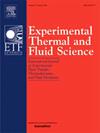Hydrophobic wettability effects on low-Weber-number droplets morphology evolution
IF 3.3
2区 工程技术
Q2 ENGINEERING, MECHANICAL
Experimental Thermal and Fluid Science
Pub Date : 2025-08-15
DOI:10.1016/j.expthermflusci.2025.111596
引用次数: 0
Abstract
The impact behavior of the droplets was significantly influenced by the substrate temperature, surface hydrophobicity, and tilt angle. To elucidate the underlying interaction mechanisms between the droplet and the surface, this paper presents an experimental investigation of the interaction between droplets impacting various heated metallic surfaces. The study utilized three distinct hydrophobic aluminum substrates and employed 4 wt% glycerol aqueous solution as the test liquid. The temperature of the metallic substrates was maintained between 80 °C to 260 °C, while the droplet impact velocity was kept constant at 0.884 m/s. Under low-temperature conditions, droplets exhibit a sequence of spreading, receding, and oscillation. In contrast, elevated temperatures induce atomization and the Leidenfrost effect; these elevated temperatures promote spreading, accelerate receding, and enhance droplet rebound. Hydrophobic surfaces inhibit maximum spreading diameter while simultaneously increasing receding velocity and rebound amplitude; stronger hydrophobicity results in a more regular rebound morphology. As the tilt angle increases, droplet spreading and rebound tend to occur in the direction of the tilt, causing changes in the trajectory, displacement, and shape of the droplets. Furthermore, the synergistic effect of high temperature and strong hydrophobicity intensifies the coupling between receding and rebound. Adjustment of the tilt angle can amplify or qualitatively alter the interdependencies among other factors. Ultimately, the macroscopic spreading characteristics are determined by the dynamic balance between the intrinsic contact angle properties and the extrinsic tilt angle.
疏水润湿性对低韦伯数液滴形态演化的影响
液滴的冲击行为受基体温度、表面疏水性和倾斜角度的显著影响。为了阐明液滴与表面相互作用的潜在机制,本文对液滴撞击不同加热金属表面的相互作用进行了实验研究。本研究采用三种不同的疏水性铝基板,并采用4wt %甘油水溶液作为测试液体。金属基体温度保持在80℃~ 260℃之间,液滴冲击速度保持在0.884 m/s。在低温条件下,液滴表现出扩散、消退和振荡的顺序。相反,升高的温度诱导原子化和莱顿弗罗斯特效应;这些升高的温度促进了扩散,加速了消退,并增强了液滴的反弹。疏水表面抑制最大扩散直径,同时增加后退速度和反弹幅度;疏水性越强,回弹形态越规则。随着倾斜角度的增大,液滴的扩散和反弹倾向于在倾斜的方向发生,导致液滴的轨迹、位移和形状发生变化。此外,高温和强疏水性的协同作用加剧了退回弹之间的耦合。倾斜角度的调整可以放大或定性地改变其他因素之间的相互依赖关系。宏观扩散特性最终由内在接触角和外在倾斜角之间的动态平衡决定。
本文章由计算机程序翻译,如有差异,请以英文原文为准。
求助全文
约1分钟内获得全文
求助全文
来源期刊

Experimental Thermal and Fluid Science
工程技术-工程:机械
CiteScore
6.70
自引率
3.10%
发文量
159
审稿时长
34 days
期刊介绍:
Experimental Thermal and Fluid Science provides a forum for research emphasizing experimental work that enhances fundamental understanding of heat transfer, thermodynamics, and fluid mechanics. In addition to the principal areas of research, the journal covers research results in related fields, including combined heat and mass transfer, flows with phase transition, micro- and nano-scale systems, multiphase flow, combustion, radiative transfer, porous media, cryogenics, turbulence, and novel experimental techniques.
 求助内容:
求助内容: 应助结果提醒方式:
应助结果提醒方式:


